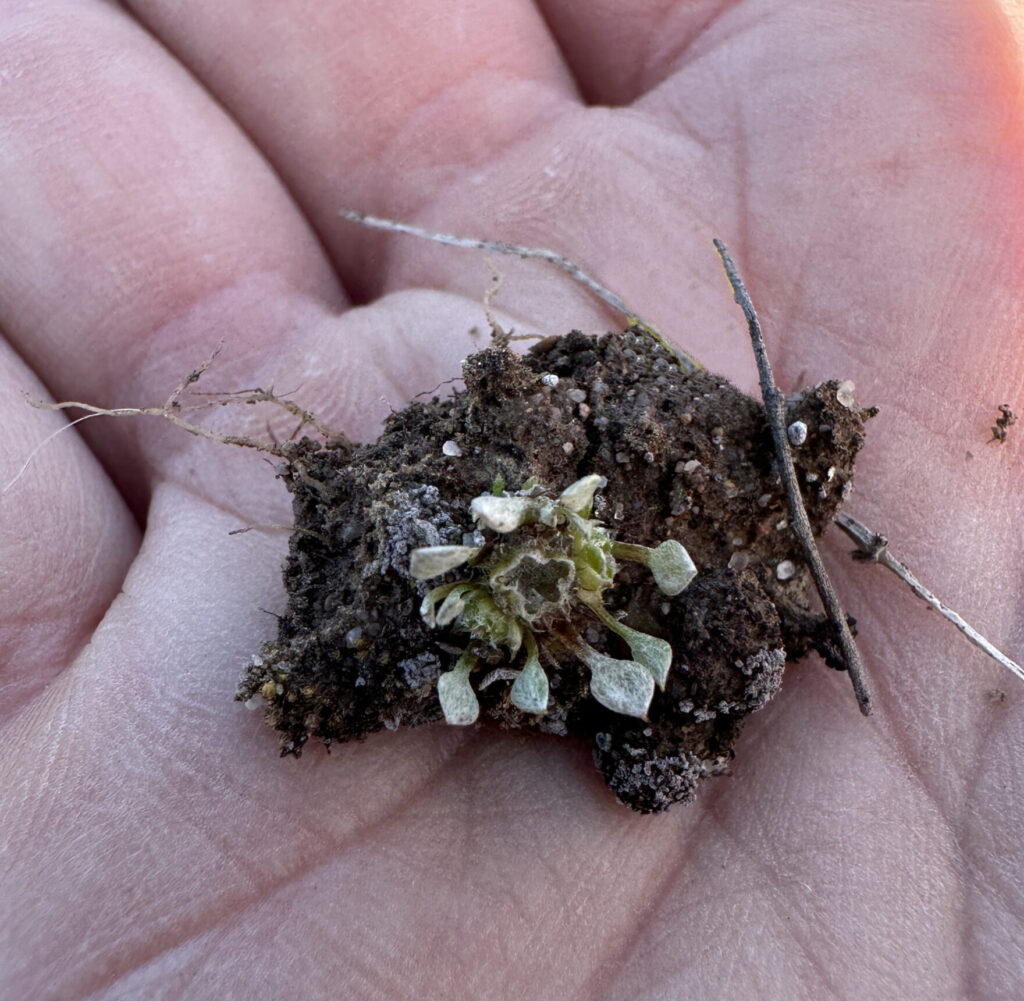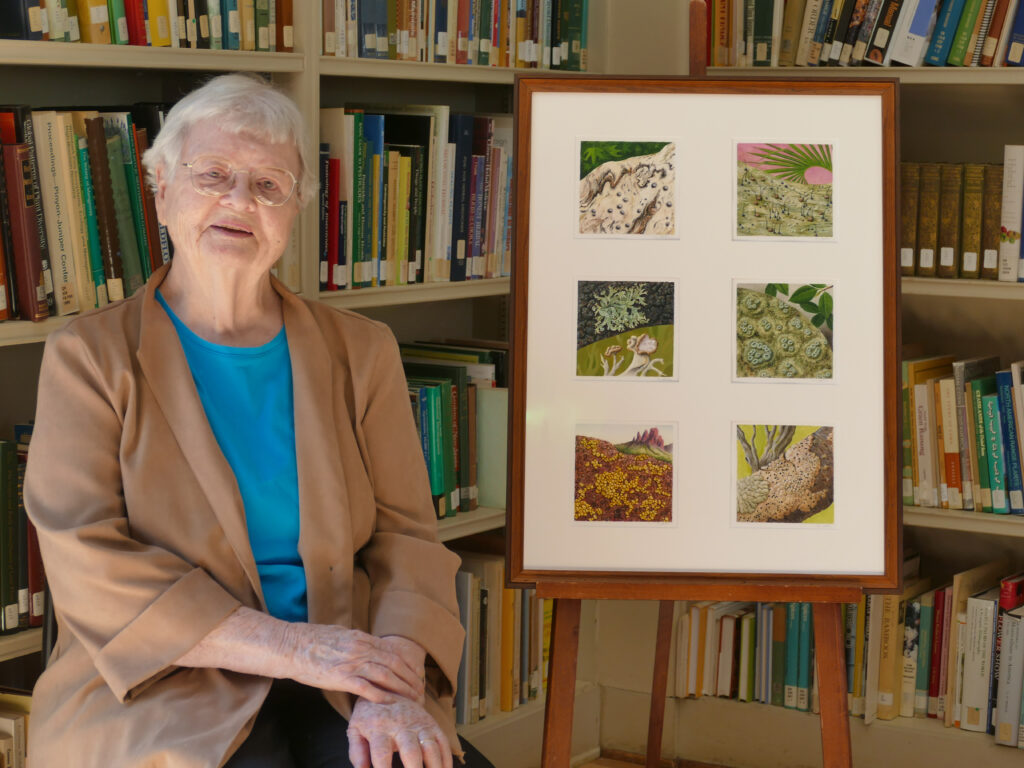Tiny Taxa Doing Big Things: “Itty-bitty” Organisms are the Focus of Santa Barbara Botanic Garden’s 11th Annual Symposium Held In Person and Online on Saturday, January 20
2024 Conservation Award Winner is Botanist, Lichenologist, and Philanthropist Shirley C. Tucker, Ph.D.

Santa Barbara, Calif. – December 19, 2023 – The public is invited to join leading biologists in a day-long exploration of “itty-bitty” organisms and their often overlooked yet critical ecological roles at “Tiny Taxa Doing Big Things,” Santa Barbara Botanic Garden’s 11th annual symposium. Seven scientists who study tiny plants and creatures each present a talk focused on their area of interest, including lichen, moss, living soil crust, flies, ants, and parasites, among others. The symposium is held Saturday, January 20, 2024, from 10 a.m. to 4:45 p.m. at the Santa Barbara County Education Office at 4400 Cathedral Oaks Road.
The talks reveal how a “small yet mighty” taxon may have an outsized influence on whole ecosystems, aid in conservation efforts, and support biodiversity on the planet. Also examined are the relationships between these diverse organisms and how cutting-edge technology is used to study them. The session culminates in a panel discussion about how to help conserve both these “tiny taxa” and the natural world at large.
Advance registration “Tiny Taxa Doing Big Things” is required for both in person and online attendance. Admission is $40 for the public, and $15 for Garden Members and students. A catered lunch is included. Attendance for the virtual-only is free, but registration is required. Register at https://sbbotanicgarden.org/classes-events/symposium-2024.
“Sometimes in life, it’s the little things that make all the difference. That’s true in nature, too,” said the Garden’s Director of Conservation, Denise Knapp, Ph.D. “Some of the biggest jobs on the planet are done by the tiniest of organisms. For example, lichens build soil, while bacteria, algae, mosses and more hold it together, then bugs and fungi fertilize and recycle. This tiny world is sometimes beautiful, sometimes bizarre, sometimes disgusting – but always fascinating.”
The winner of this year’s Pritzlaff Conservation Award is world-renowned botanist, lichenologist, and philanthropist Shirley C. Tucker, Ph.D. Unable to attend the Symposium, she is still honored at this year’s at this event for her many conservation achievements in California and around the world. (Biography and award details are below.)
An exhibit related to the Symposium, and sharing the title “Tiny Taxa Doing Big Things, is now on view in the Garden’s Pritzlaff Conservation Center Gallery. It features magnified views of small yet significant organisms and insights from Garden experts who study their intricate relationships. More information is available at https://sbbotanicgarden.org/classes-events/tiny-taxa-doing-big-things-gallery-exhibit. Gallery hours are daily from 10 a.m. to 5 p.m. and it is free to visit with Garden admission. Reservations are required for Garden admission. Visit www.sbbotanicgarden.org/visit/hours-reservations.
“Tiny Taxa Doing Big Things” Symposium is presented by the Nakashima-Rennie Family. Sponsors include Arroyo Seco Construction.
Symposium Schedule
10 – 10:30 a.m. Welcome and presentation of the Conservation Award by Denise Knapp, Ph.D., Director of Conservation, Santa Barbara Botanic Garden
10:15 – 11 a.m. Lichens: “Nature’s Undervalued Secret Service Agents” by Rikke Naesborg, Ph.D., Lichenologist, Santa Barbara Botanic Garden
Lichens are often underappreciated despite serving important ecosystem functions. So why are lichens—nature’s secret service agents—rarely considered for conservation?
11 – 11:30 a.m. “Mosses and ‘Worts’: Nature’s Complex, Unique Ecosystem Servants” by Jim Shevock, Ph.D., Research Associate, California Academy of Sciences
Mosses, liverworts, and hornworts (bryophytes) are the earliest land plants that still survive today. Explore the world of these unique organisms, which also have a special super-power that helps them deal with drought.
11:30 a.m. – 12 p.m. “The Earth’s Living Skin: How Biocrusts Make Ecosystems Work, and How We Can Save Them” by Matthew Bowker, Ph.D., Professor, Northern Arizona University
Biological soil crusts (biocrusts) are like a protective living skin over the surface of soil, but can be lost due to human-caused disturbances. Find out about new techniques to hasten their recovery.
12 – 12:50 p.m. Lunch
12:50 – 1:20 p.m. “Big Impact – Small Bodies: Why Do We Need Flies?” by Erica McAlister, Ph.D., Senior Curator of Diptera, Natural History Museum of London
Flies are some of the most maligned animals in the world, but without them it would be a much worse place. From just 7cm down to 0.4mm in size, these mini marvels are massive in importance.
1:20 – 1:50 p.m. “Ant Bathing: The Benefits of Closely Watching Ants and Their ‘Creepy-Crawly’ Guests” by Zachary Phillips, Ph.D., Terrestrial Invertebrate Conservation Ecologist, Santa Barbara Botanic Garden
Dr. Phillips reviews how “sit spot methods” led to forms of awareness, knowledge, and appreciation in a research project on leaf-cutter ants and a strange arthropod that lives inside their nests.
1:50 – 2:20 p.m. “Parasites: The Little Giants Inside All of Us” by Kevin Lafferty, Ph.D., Senior Ecologist with the U.S. Geological Survey’s Western Ecological Research Center
Despite their small size, the prevalence of parasites in ecosystems allows their collective biomass to outweigh larger organisms, and this abundance underscores their significant ecological role.
2:20 – 2:50 p.m. “Understanding Species Interactions Through the Building Blocks of Life” by Kristen Hasenstab-Lehman, Conservation Geneticist, Santa Barbara Botanic Garden
Attendees discover how DNA barcodes are used in conservation to understand animal diets, from tiny snails to charismatic foxes, and the importance of collaborative biodiversity science that underlies these molecular tools.
2:50 – 3:20 p.m. Break
3:20 – 4 p.m. Panel Discussion with All Speakers
About 2024 Pritzlaff Conservation award Winner Shirley C. Tucker, Ph.D.
World-renowned botanist, lichenologist, and philanthropist Shirley C. Tucker earned her doctorate at the University of California, Davis, where she studied inflorescence development. She served on the faculty of Louisiana State University (LSU) from 1968 to 1995, retiring with the university’s highest distinction – the Boyd Professor of Botany.
During her time at LSU, she served as the president of both the Botanical Society of America and the American Society of Plant Taxonomists, the two largest professional societies for botany in the United States.
After retiring, she moved to Santa Barbara and continued her lichenological work at Santa Barbara Botanic Garden as a Research Associate. The Garden’s Lichenarium holds over 9500 of her more than 38,000 lichen collections from California to Australia. Tucker’s large contribution to the field is evident by the six lichen species lichenologists have chosen to name after her. She remains active in research, having published over 140 peer-reviewed articles on floral morphology, plant systematics, and lichens of California.

About the Pritzlaff Award
Established in 2007, the Honorable John C. Pritzlaff Conservation Award recognizes conservation achievements in California and around the world. It honors the former Garden Trustee’s life-long commitment to conservation and serves to inspire others to understand the importance of conservation and to take action.
Last year’s winners were three “heroes” who led conservation efforts on the Channel Islands, Kate Faulkner, formerly with the Channel Islands National Park; Peter Schuyler, volunteer and philanthropist; and Baja California nonprofit organization Grupo de Ecología y Conservación de Islas. Other recent honorees include Carla D’Antonio, Ph.D., professor and researcher at the University of California, Santa Barbara (2021); Richard Louv, author and co-founder of the Children & Nature Network (2020); and Gretchen Daily, Ph.D., Stanford professor and founder of the Natural Capital Project (2019). See a full list at https://sbbotanicgarden.org/conservation/our-honorees.
###
 Donate
Donate